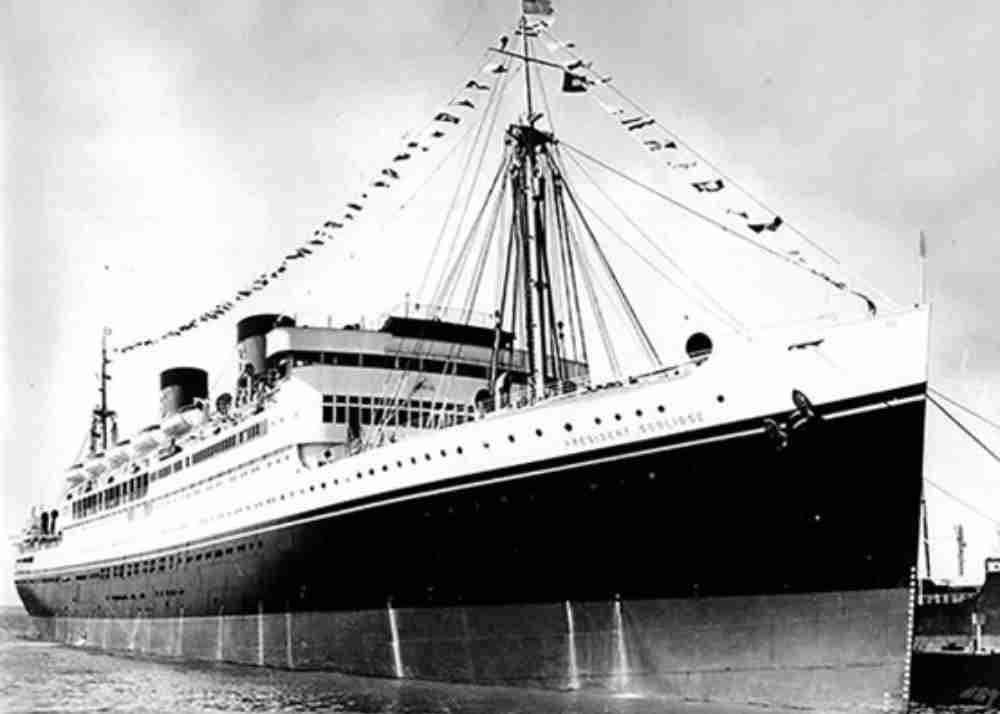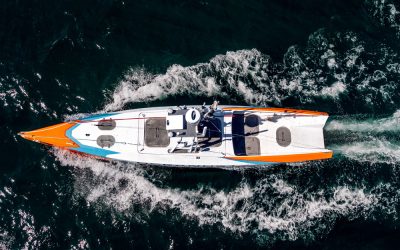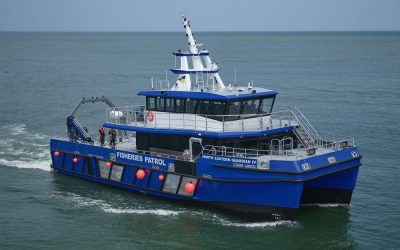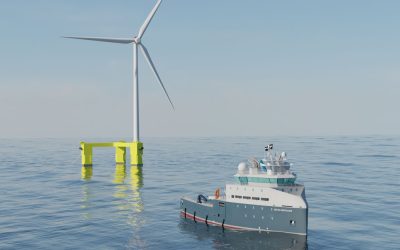Technical Presentation 4 October 2023: SS President Coolidge: Sinking and the Shipwreck
Carl Linkenbagh, a Senior Systems Engineer working within the Department of Defence on maritime projects, gave a presentation titled SS President Coolidge: Sinking and the Shipwreck to a joint meeting of the NSW Section and IMarEST ACT & NSW Branch at the Royal Prince Edward Yacht Club, Point Piper, with the Secretary of the IMarEST, Geoffrey Fawcett, as MC and streamed live on 4 October. The presentation was attended by 15 with an additional 13 online.
The Ship
SS President Coolidge was one of two luxury passenger ships (the other being President Hoover) built by Newport News Shipbuilding and Drydock Company of Newport News, VA, for Dollar Steamship Lines. The keel for President Coolidge was laid on 22 April 1930 and the ship was delivered on 1 October 1931. President Hoover was completed in 1930. They were the largest and most advanced merchant ships built in the United States up to that time.
Principal particulars of the vessels were:
Length OA 654 ft (199 m)
Beam 81 ft (24.7 m)
Depth 52.0 ft (15.8 m)
Draft 34 ft (10.4 m)
GT 21 936
Passengers 307 First class
133 Tourist class
548 Third class
988 Total
Crew 324
Power Westinghouse turbo-electric
26 500 shp (19 760 kW)
Boilers 12×Babcock & Wilcox watertube
300 psi (2070 kPa)
Propellers 2×fixed pitch, 3 blade
Speed (maximum) 21 kn
Range 19 500 n miles (at cruising speed)
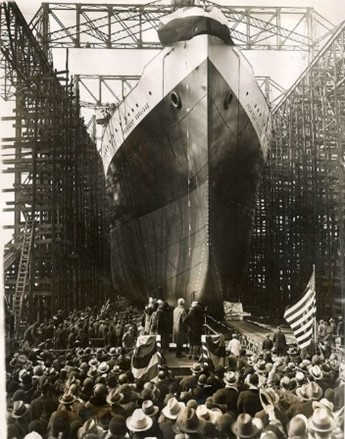
Launching of SS President Coolidge (Photo courtesy Todd Neitring)
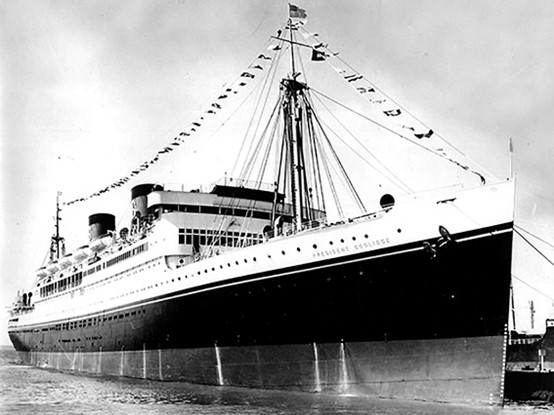
SS President Coolidge
(Photo from ocealinersmagazine.com website)
Peacetime
President Coolidge and President Hoover were home-ported in San Francisco and ran regular trans-Pacific voyages to the Philippines (Manila), China (Shanghai) and Japan (Kobe) via Honolulu , with occasional round-the-world voyages which continued westbound from Manila via Singapore, the Suez Canal, the Mediterranean Sea, New York City, the Panama Canal and thence back to San Francisco.
The vessels were designed specifically to accommodate American holiday makers seeking sunshine and adventure in the Pacific and Far East and were among the first purpose-built passenger ships intended primarily for leisure voyages, in contrast to the much larger and faster ocean liners operating line voyages between Europe and North America on the lucrative North Atlantic route. Passenger luxuries included spacious staterooms and lounges decorated in the highly fashionable art deco style of the time, private telephones, two saltwater swimming pools, a barbers’ shop, beauty salon, gymnasium and soda fountain.
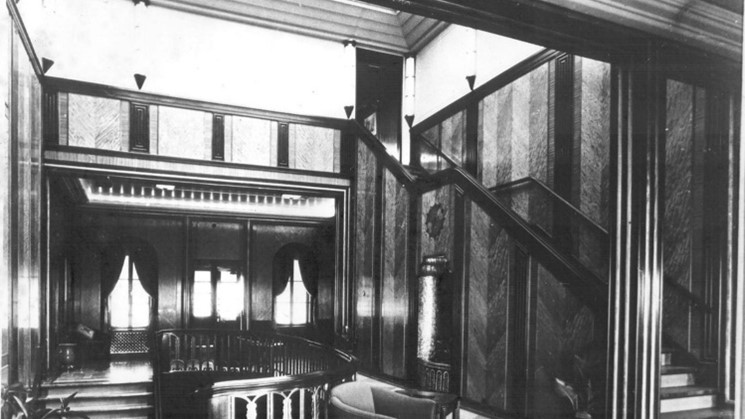
Stair on SS President Coolidge
(Photo from TDI Blog website)
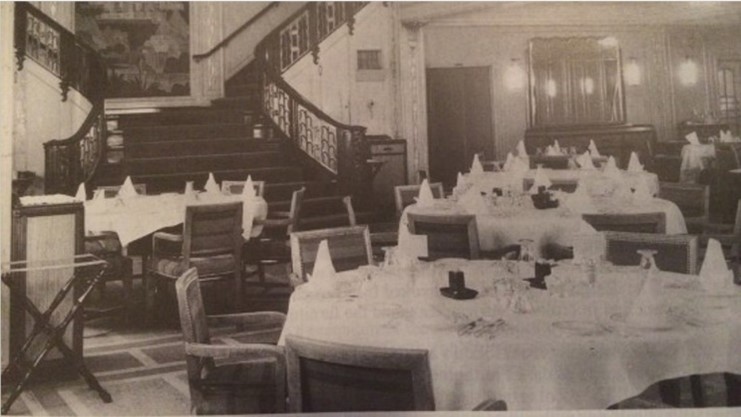
Dining room on SS President Coolidge
(Photo from TDI Blog website)
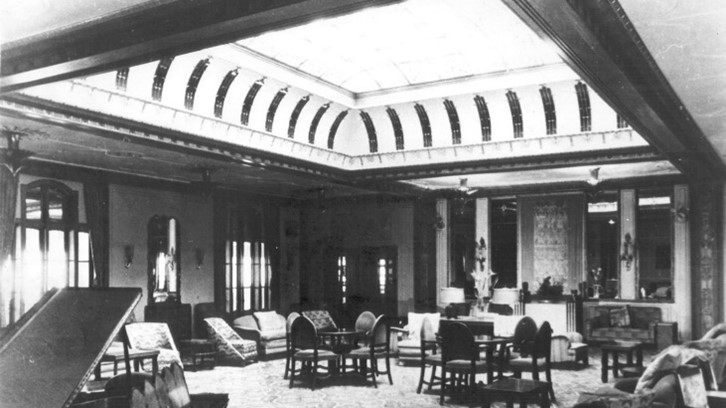
Lounge room on SS President Coolidge
(Photo from TDI Blog website)
President Coolidge set a new eastbound speed record of 12 days from Yokohama to San Francisco in April 1931, and a further eastbound speed record of 4 days from Honolulu to San Francisco in January 1933.
Following a minor collision with the tanker Frank H. Buck in San Francisco March 1937 the Dollar Steamship Company entered administration (via US Government takeover) in March 1938. President Coolidge, with all former Dollar Line vessels, were transferred to American President Lines by August 1938, as recognised by the United States Maritime Commission.
World War II
In June 1941, with the war in Europe well underway and the likelihood of war in the Pacific with Japan increasing by the day, the US War Department requisitioned President Coolidge as a troop transport vessel reinforcing garrisons in the Pacific. On 7 December 1941 Japan attacked Pearl Harbor and on 19 December President Coolidge evacuated 125 critically injured naval patients from Hawaii, reaching San Francisco on 25 December.
President Coolidge continued to perform military duties in her pre-war civilian condition. Only in early 1942 was she hastily converted into a troopship. Many of her civilian fittings were either removed for safe keeping or boarded over for their protection. Her accommodation was reorganised to provide capacity for 5000 troops. 3 inch (75 mm) guns were mounted, she was painted haze gray and the War Shipping Administration operationally assigned her to the US Navy for troop transport voyages between the US and forward bases in the Pacific
The Sinking
The Pacific in late 1942 was the stage for one of the most intense periods of naval warfare in maritime history. The allied campaign at the time was focussed on repelling the Japanese advance across the Pacific and this resulted in many fierce naval battles. It was this theatre of war that President Coolidge was bound for when she departed San Francisco for the final time on 6 October 1942 under the command of Captain Henry Nelson (American President Lines). On board were approximately 5000 troops and cargo holds packed with vehicles, weapons, provisions, medical equipment and other supplies vital to the war effort.
Following a four-day visit to Noumea (New Caledonia), where she arrived on 20 October 1942, the ship sailed for the island of Espiritu Santo on 24 October 1942. Her destination was Point HYPO, a code-worded rendezvous position to the south-east of the approaches to the Segond Channel. Espiritu Santo, the largest island in Vanuatu (then known as the New Hebrides), was the site of a large military base and harbour which quickly became a vital strategic asset in the allied Pacific campaign. It was noteworthy for its airfields and the deep-water anchorage which provided a secure port for the repair and re-supply of allied merchant and warships.
From mid-1942 the entrances to the Segond Channel were heavily protected by mines laid in two lines across its deep-water approaches, with a ‘safe’ (or swept) channel maintained for ships between the islands of Aore and Tutuba.
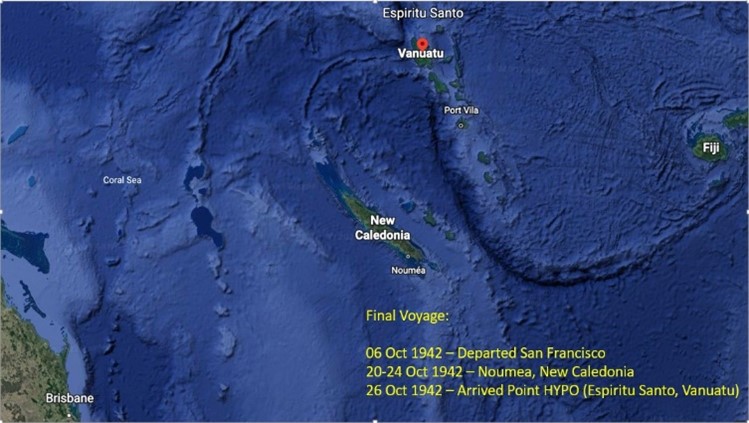
Location of Vanuatu
(Chart courtesy Carl Linkenbagh)
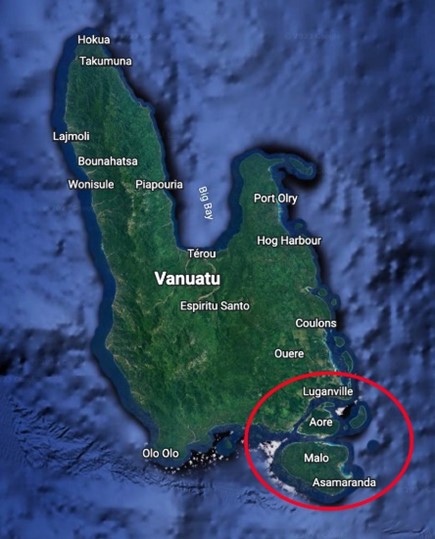
Vanuatu, Aore and Tutuba Islands
(Chart courtesy Carl Linkenbagh)
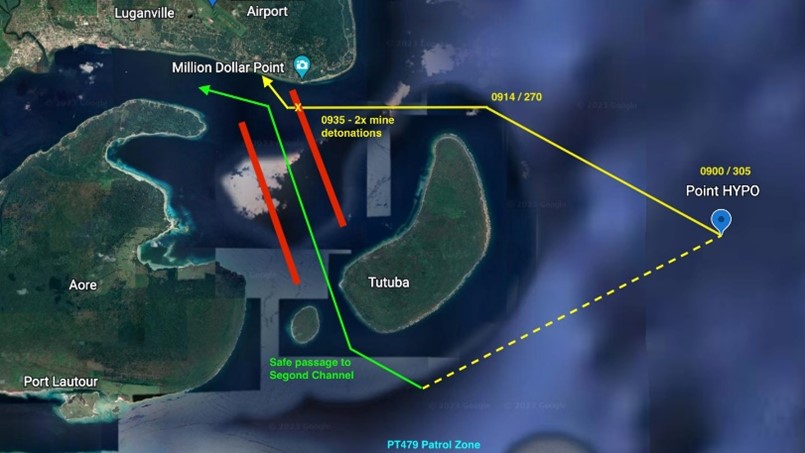
Minefield (red) and vessel’s track (yellow)
(Chart courtesy Carl Linkenbagh)
However, as he approached Point HYPO at 0900 on the morning of 26 October 1942, Captain Nelson had not been briefed on the minefield, safe passage or pilotage requirements for entry into the Segond Channel by the US Navy. It had been decided by local military commanders that a merchant ship captain had no requirement to be briefed on the location of the minefields in the interests of maintaining operational secrecy.
On arrival at Point HYPO, Captain Nelson assessed his options for bringing the ship safely into the anchorage. In the absence of an escort, pilot, further orders and/or instructions—and with a legitimate concern of enemy submarines operating in the immediate area—he maintained full speed and steered for the eastern entrance of the Segond Channel between Espiritu Santo and Tutuba, which was the nearest, deepest and widest entrance into the anchorage beyond.
Unaware of the danger lurking below, the ship made a turn to port at 0914 off Tutuba Island heading due west, placing the minefield dead ahead. At approximately 0935 a US Navy shore station in the vicinity of Million Dollar Point urgently signalled President Coolidge (via flashing light) “STOP. YOU ARE STANDING INTO MINES”. Instantly, Captain Nelson ordered the main engines crash stopped in an effort to stop the ship. However, this was to no avail.
President Coolidge struck two mines on the outer line of the minefield, both of which breached the engine room and aft machinery spaces. The ship immediately began to flood, was losing headway and took on a list to port.
Captain Nelson rapidly assessed the situation. He ascertained very quickly that the ship was seriously damaged. At 0938 he ordered a hard turn to starboard and aimed the bow of the ship directly at the northern shore of the Segond Channel, with the intention of running her hard aground and preventing her sinking. As the bow rode up on the reef he gave the order to abandon ship. What followed was an orderly, unfussed evacuation of over 5000 persons onboard, many of whom did not even get their feet wet as they were landed ashore. All but two persons were safely disembarked from the ship.
What Captain Nelson was less aware of was that under the stern of the ship was 70 m of water and the fact that the seabed dropped sharply at a steep angle from where the bow was grounded. As the evacuation progressed, the ship continued to flood. Her list increased to the point where, at 1052, she rolled over completely on her port side and sank stern first to the bottom of the channel, sliding down the steep underwater slope in the process.
The immediate aftermath of the sinking was significant, noting that there were now 5000 troops ashore in Santo with nowhere to go and inadequate resources ashore to support them. Not to mention the fact that thousands of tons of valuable cargo, including the entire supply of quinine—the only available treatment for malaria—for the South Pacific, was now lost and totally inaccessible on the seafloor.
Following the incident there were two separate Boards of Inquiry and a Military Commission, both of which found—having regard to all of the circumstances—that Captain Nelson was not at fault. It is notable that Admiral William F. Halsey USN attempted to deflect liability away from the US Navy; however, Captain Nelson’s actions on the morning of 26 October 1942 were fully vindicated and he was acquitted of responsibility for the sinking.
After World War 2 President Coolidge was largely forgotten by her owners and the US Government. Excluding some initial attempts at equipment salvage during the war, the ship lay mostly undisturbed on the seafloor until commercial salvagers arrived in the late 1960s. Numerous salvage efforts resulted in removal of both propellers, spare propeller blades, bunker oil and sources of valuable metals such as brass casings of shells, electric motors, metals from the engine room, junction boxes and copper tubing and fittings. Numerous artefacts in the form of personal and decorative items have also been removed. These salvage attempts have made an indelible mark on the wreck.
Fortunately, a moratorium on further salvage was declared by the Government of Vanuatu on 18 November 1983 and the wreck was preserved as a historic site which is now accessible to recreational scuba divers.
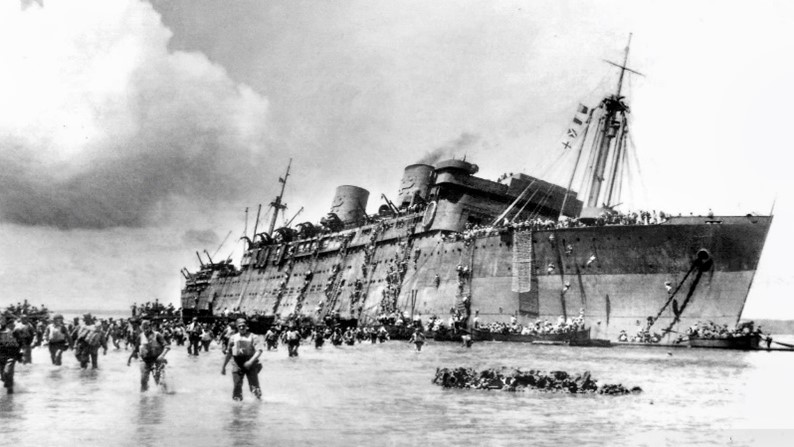
Abandon ship!
(Photo from RNZI website)
The Wreck Today
Today, President Coolidge lies silently on her port side at depths ranging from 21 m (at the bow) to 70 m (at the stern). The wreck is located near the eastern entrance to the Segond Channel, approximately 6 km from the town of Luganville.
The hull of the ship is largely intact; however, after 81 years on the seafloor, the superstructure has almost totally collapsed, as has some of her internal structure. This is primarily due to the effects of several earthquakes. However, the ship is remarkably complete and diving her offers a direct insight into a vessel with a fascinating history.
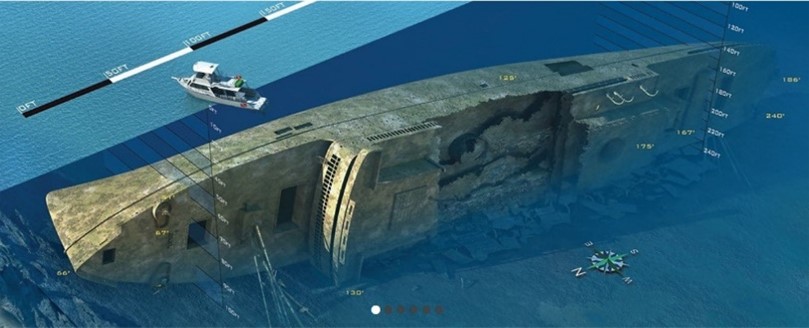
The wreck today
(Diagram courtesy Carl Linkenbagh)
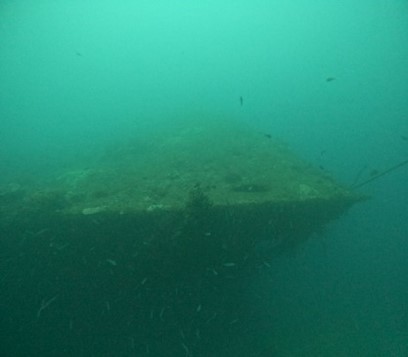
Bow of the ship at 21 m
(Photo courtesy Carl Linkenbagh)
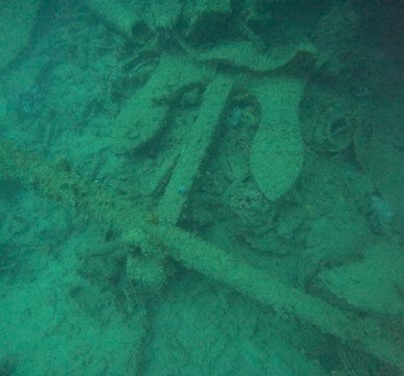
The bow anchor
(Photo courtesy Carl Linkenbagh)
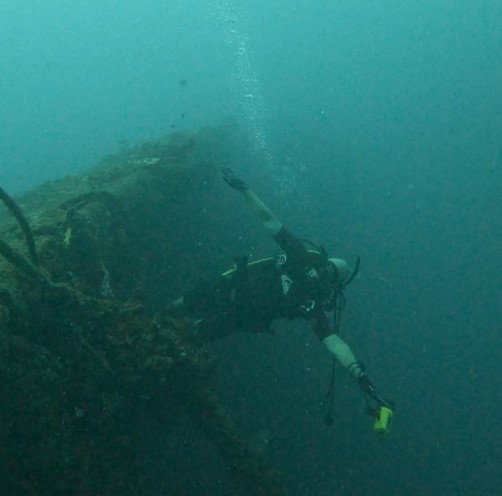
The presenter emulating Kate Winslett on the bow of Titanic
(Photo courtesy Carl Linkenbagh)
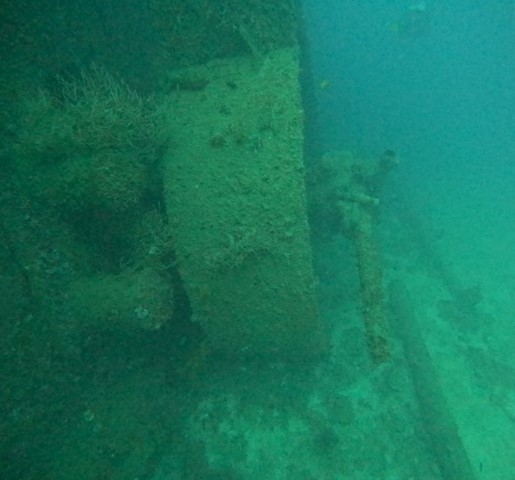
Gun mounting on the main deck
(Photo courtesy Carl Linkenbagh)

(Photo courtesy Carl Linkenbagh)
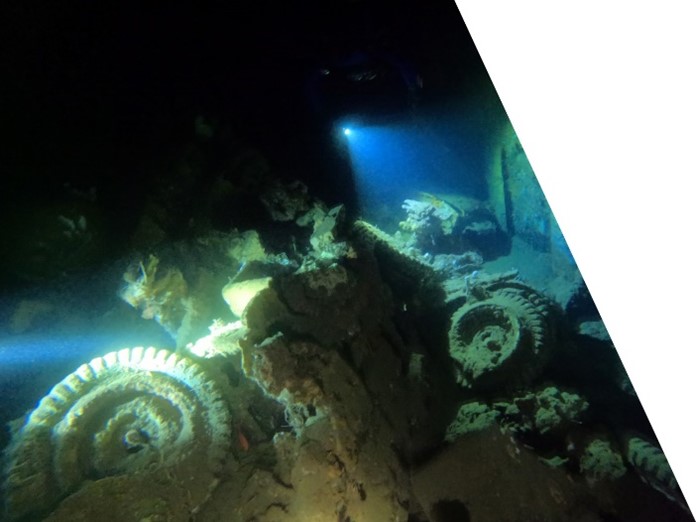
Jeep in No. 2 cargo hold
(Photo courtesy Carl Linkenbagh)
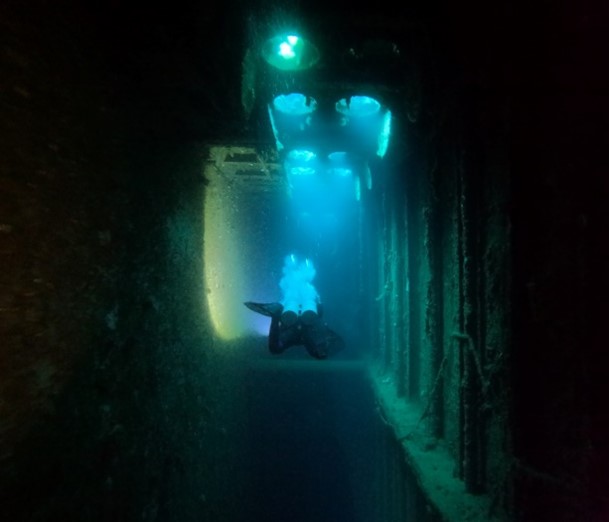
Exploring a passageway with light through portholes
(Photo courtesy Carl Linkenbagh)
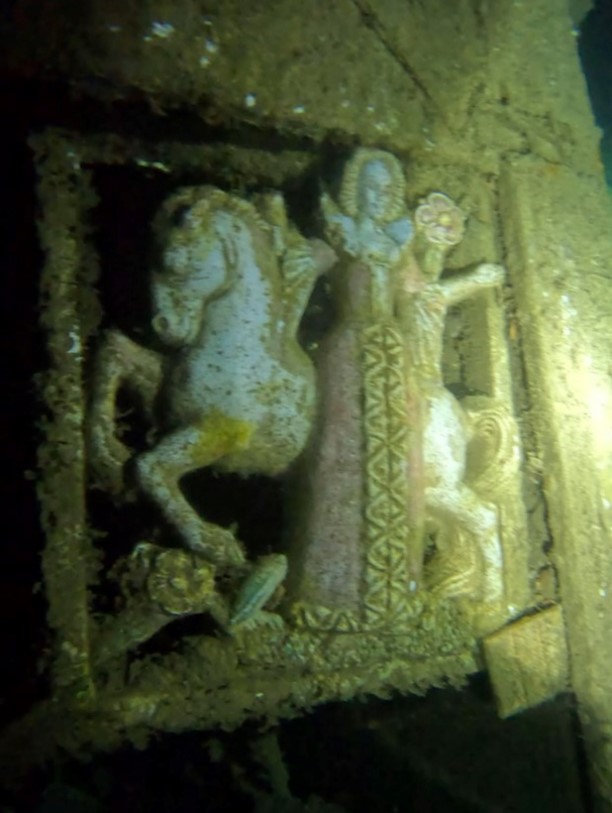
The Lady
(Photo courtesy Carl Linkenbagh)
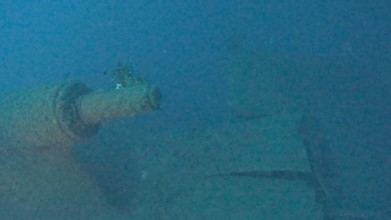
Propeller shaft and rudder
(Photo courtesy Carl Linkenbagh)
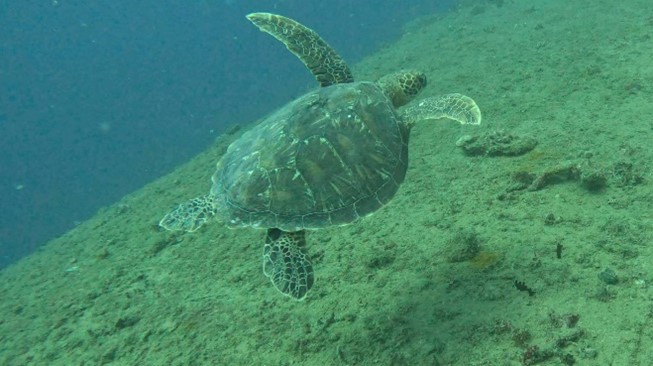
Turtle at the wreck
(Photo courtesy Carl Linkenbagh)
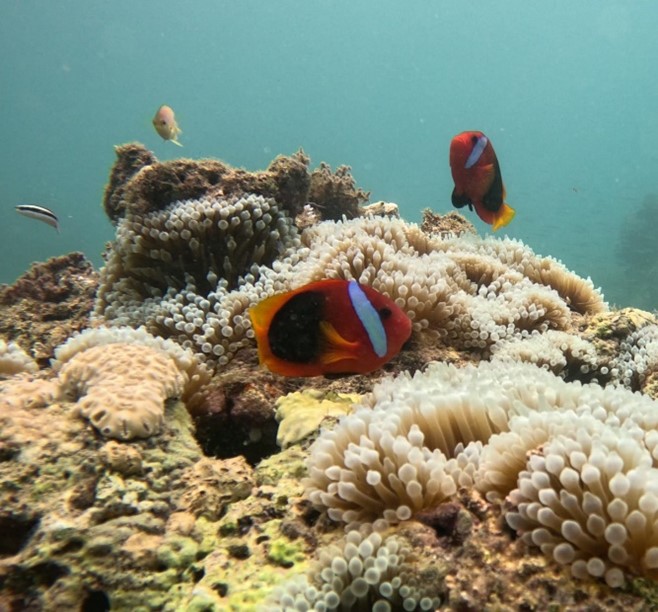
Clown fish at the 6 m decompression stop
(Photo courtesy Carl Linkenbagh)
Diving the Wreck
Diving President Coolidge is an exceptional experience. This is largely due to the immense scale of the ship, the huge variety of things to see (both natural and man-made) and the complexities and risks involved in diving her. Since recreational diving on the wreck was pioneered by the late Allan Power from the mid-1980s, President Coolidge has become an iconic, must-see destination for divers from all over the world. There are wartime artefacts to be seen on every dive such as guns, cannons, jeeps, helmets, trucks and personal supplies and remnants of her luxurious art deco past which includes an iconic porcelain relief statue of “The Lady” (a must-see item for any diver visiting the wreck), chandeliers, and a mosaic tile fountain.
The ship has also become a spectacular marine habitat and the permanent home of many resident creatures such as reef fish, barracuda, lionfish, sea turtles, moray eels and various types of coral. One of the more spectacular dives on the wreck is a night dive into No. 2 Cargo Hold. At a depth of approximately 25–30 m, you enter the vast, cavernous space. Lights are turned off and everything is pitch black until schools of bioluminescent fish emerge, creating a mesmerising spectacle.
Another remarkable attribute is the wreck’s accessibility and the ease with which she can be accessed. President Coolidge is without doubt one of the most spectacular shore dives anywhere in the world. The water is a very comfortable 28oC, visibility is typically in the order of 15–20 m with calm surface conditions, Santo’s natural beauty is all around and, after the day’s diving is done, there is an abundance of fresh fruit, kava, Tusker beer and good humour from Santo’s very friendly locals whose clocks are always set to ‘island time’.
Nowhere else in the world is diving such an immense and historically-significant shipwreck so easy and enjoyable. The presenter has now made 22 dives on this wreck (down to a maximum depth of 55 m) and is going back for more!
Dive Profile
The average dive time is approximately 55 min ±10 min. Recreational dives are conducted on air (i.e. 21% oxygen in order to manage oxygen partial pressure within acceptable limits) and are led by highly-experienced, local dive guides following well-established routes both inside and outside the wreck.
A typical dive profile within the 30–40 m range includes:
- descent from the surface to the ‘deco area’ (6 m) and then to the bow (21 m) — 5 mins;
- bottom time — up to 10 min at maximum depth;
- ascent to the ‘deco area’ from maximum depth (whilst swimming ‘up’ the wreck) — up to 25 min; and
- decompression at 6 m (with deeper stops as required) — up to 25 min.
All dives on the wreck, even for recreational divers, typically result in a decompression obligation due to depth and accumulated bottom time. It is advisable for anyone considering diving President Coolidge at any level to remain within the limits of their own training, experience and self-assessed level of competency.
The wreck is an ideal location for technical diving and these skills are essential for any dives beyond recreational limits. Technical dives—which extend below 40 m, incur mandatory decompression obligations and may require the use of mixed gases (such as Trimix 21/35 or 18/45)—enable access to deeper parts of the wreck down to a maximum depth under the stern of 70 m. Deeper parts of the wreck are far less travelled and seeing the ships’ graceful counter stern, enormous rudder and propeller shafts is a spectacular and unforgettable sight.
Conclusion
President Coolidge is the largest shipwreck accessible to recreational divers in the world.
Appropriate qualifications and experience are essential to dive the wreck due to the cumulative risk associated with depths, dive profiles, decompression obligations, and complex wreck penetrations—all at the same time.
It is a magnificent and awe-inspiring experience because of the wreck’s accessibility, enormous size, the huge variety of things to see and the opportunity to connect with history.
Diving President Coolidge pushed the presenter right to the limit of his training, experience and comfort zone—and beyond—and he can’t wait to go back and do it again!
Questions
Question time was lengthy and elicited some further interesting points.
The presentation was not recorded.
The vote of thanks was proposed, and the “thank you” bottle of wine presented, by John Jeremy. The vote was carried with acclamation.
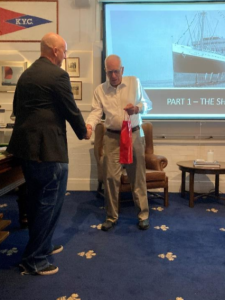
Carl Linkenbagh (L) and John Jeremy (Photo Phil Helmore)
